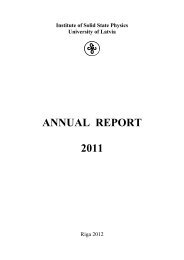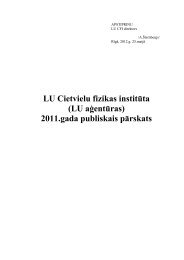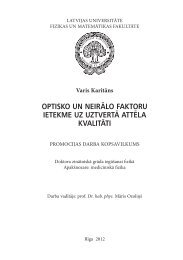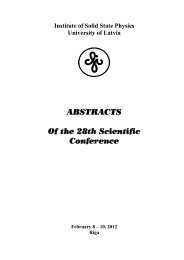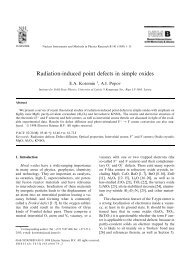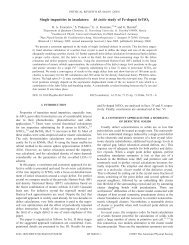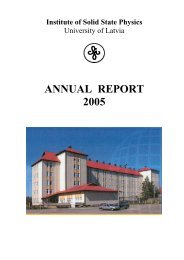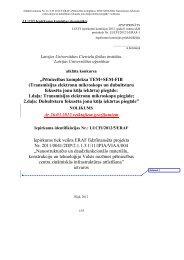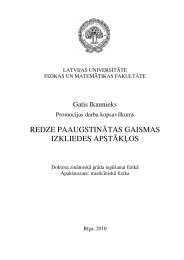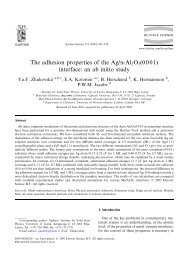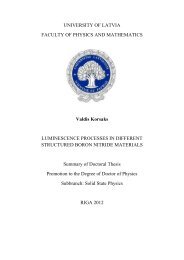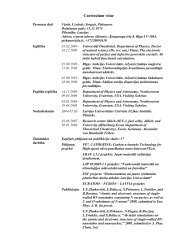Annual Report 2012 - Latvijas Universitātes Cietvielu fizikas institūts
Annual Report 2012 - Latvijas Universitātes Cietvielu fizikas institūts
Annual Report 2012 - Latvijas Universitātes Cietvielu fizikas institūts
Create successful ePaper yourself
Turn your PDF publications into a flip-book with our unique Google optimized e-Paper software.
THERMAL AND OPTICAL PROPERTIES OF RED LUMINESCENT GLASS<br />
FORMING SYMMETRIC AND NON SYMMETRIC STYRYL-4H-PYRAN-4-<br />
YLIDENE FRAGMENT CONTAINING DERIVATIVES<br />
Aivars Vembris a , Elmars Zarins b , Janis Jubels b , Valdis Kokars b , Inta Muzikante a ,<br />
Arunas Miasojedovas c , Saulius Jursenas c<br />
Dyes with amorphous structure deposited from organic solvents and having good fluorescence<br />
properties show potential for photonic device applications. Organic glass-forming symmetric<br />
and non symmetric styryl- derivatives of 2(2,6-substituted-4H-pyran-4-ylidene)-malononitrile (it<br />
has backbone of known laser dye 4-(dicyanomethylene)-2-methyl-6-[p-(dimethylamino)styryl]-<br />
4H-pyran), 2(2,6-substituted-4H-pyran-4-ylidene)-1H-indene-1,3(2H)-dione and 2(2,6-<br />
substituted-4H-pyran-4-ylidene)-pyrimidine-2,4,6(1H,3H,5H)-trione were synthesized and<br />
investigated. Glass transition temperatures higher than 110ºC were achieved. The absorption<br />
bands in dichloromethane solution cover the spectral region from 450 nm to 600 nm with<br />
fluorescence maxima between 580 nm and 690 nm. Photoluminescence quantum yields of the<br />
compounds in solution are between 0.3 and 0.55, which is reduced by one order in thin<br />
amorphous film prepared from volatile organic solvents. Incorporation of bulky trityloxyethyl<br />
groups in the derivatives results in significant reduction of aggregate formation. Thus<br />
fluorescence concentration quenching is reduced, enabling higher doping levels as compared to<br />
the unsubstituted 4-(dicyanomethylene)-2-methyl-6-[p-(dimethylamino)styryl]-4H-pyran dye.<br />
Figure 1. Synthesis of glass forming styryl-<br />
4H-pyran-4-ylidene fragment containing<br />
derivatives<br />
Table 1. Thermal properties of<br />
synthesized compounds. T g – glass<br />
transition temperature, T m – melting<br />
temperature, T d – decomposition<br />
temperature<br />
DWK JWK ZWK<br />
1 2 1 2 1 2<br />
T g , - 112 120 127 110 118<br />
T m , 250 148 146 144 212 144<br />
T d , 267 296 266 283 274 284<br />
Figure 2. Absorption (dashed lines) and<br />
fluorescence (solid lines) spectra of<br />
compounds DWK, JWK and ZWK in dilute<br />
solutions and neat films.<br />
Figure 3. The dependence of<br />
photoluminescence PLQY on concentration<br />
of DWK-1 and DWK-2 and DCM dyes in<br />
PMMA matrix.<br />
114



